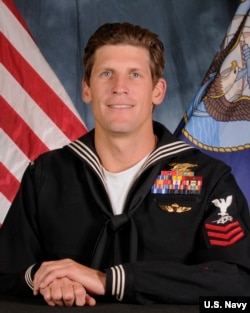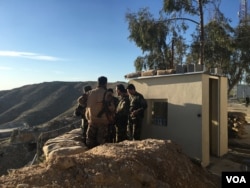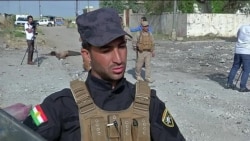A U.S. Navy SEAL killed Tuesday when Islamic State (IS) fighters punched through Kurdish lines in northern Iraq was part of a Quick Reaction Force, sent in to extract other U.S. troops trapped by the surprise offensive.
According to U.S. military officials, a small team of U.S. advisers had been meeting early Tuesday with a Kurdish Peshmerga unit in the town of Telskuf, about 30 kilometers north of Mosul.
"They were in contact [with the enemy], they couldn't get away," Operation Inherent Resolve Spokesman Col. Steve Warren told reporters during a video news conference from Baghdad.
The so-called Quick Reaction Team, on standby in case of an emergency, was sent in to retrieve them.
"When the QRF arrived, they fought out," Warren said.
U.S. officials said Quick Reaction Forces are routinely used to back up missions like the one in Telskuf, but it has been months since one of the teams was called into action.
The Navy identified the lone casualty as Special Warfare Operator 1st Class Charles Keating IV, a 31-year-old with previous experience in Iraq and Afghanistan.
He was shot during what Warren described as "a dynamic gunfight" pitting the U.S. and Peshmerga forces against more than 125 IS fighters.
Keating was evacuated by helicopter to a U.S. medical facility in Irbil, where he died from his injuries.
'Large fight'
Warren said a number of Peshmerga fighters were also killed and both of the U.S. Black Hawk helicopters used in the extraction operation were damaged by small arms fire.
"This was a large fight, no question about it," Warren said, "one of the largest we've seen recently."
U.S. forces also called in for help from the air, getting it from 11 manned aircraft, including fighter jets, B-52 bombers, A-10 ground attack aircraft and two drones, all of which continued to carry out strikes after U.S. forces had left the area.
In all, the U.S. says 58 IS fighters were killed in the strikes, which also destroyed three mortar systems, two truck bombs, a bulldozer and more than 20 other vehicles used in the assault.
Still, it was not until darkness had fallen that Peshmerga forces managed to clear the area of IS forces, claiming a total of 80 IS fighters had been killed.
U.S. military officials said the last time IS tried to carry out an attack on a similar scale was last December, when several hundred IS fighters targeted Tal Aswad.
Despite the magnitude and complex nature of the IS assault Tuesday on Telskuf, Warren insisted there was "no indication" IS knew about the presence of the U.S. military advisers.
"The enemy's intent, we believe, was to seize the town,” he said.
"This enemy has suffered a string of defeats," he added. "When they are back on their heels, often they will try one of these more high-profile, high-visibility attacks in an effort to gain some attention."
How did IS do it?
Still, there are questions as to how IS was able to mass such a large force — including three truck bombs, a bulldozer and dozens of other vehicles — so close to the Peshmerga front lines without detection.
Peshmerga fighters speaking to VOA following the battle in Telskuf said the IS firepower was impressive and that the Peshmerga initially had to retreat because they were outgunned.
Witnesses Describe Deadly IS Attack on Navy SEAL:
"Clearly they were able to, over time, infiltrate individuals or vehicles, one or two at a time and then dash out of there under the cover of darkness Tuesday morning," Warren said.
For months, some intelligence and military officials have cautioned that even though IS was being pushed back, it retained its ability to adapt.
"They're willing to trade space for time," one U.S. official told VOA last month, warning that the terror group seemed to be gearing up to defend its strongholds of Raqqa, Syria and Mosul. "You're going to see a really tough fight."
Flaws in coalition strategy?
There are also some concerns the surprise offensive in Telskuf may reveal some flaws in the U.S. and coalition's anti-IS strategy.
"With the force structure we have in place, we are vulnerable," said Christopher Harmer, senior naval analyst at the Institute for the Study of War.
"Because they blend in so well with the population and are, for all practical purposes, indistinguishable from the population when using long-distance surveillance technology, they can mass and attack at the time and place of its choosing," he added.
Following a meeting with coalition defense ministers Wednesday in Germany, U.S. Defense Secretary Ash Carter warned that the danger was far from over.
"These risks will continue," he said. "All of our friends and allies across the counter-ISIL coalition can and must do more." ISIL is an acronym for Islamic State.














